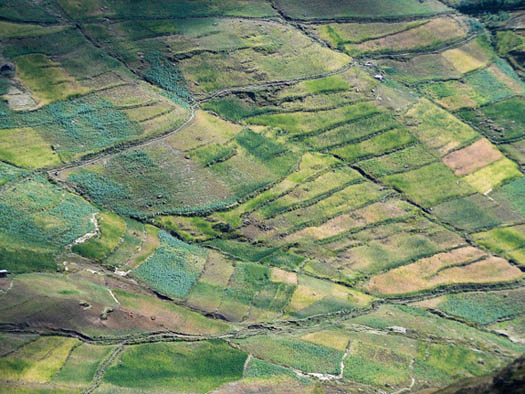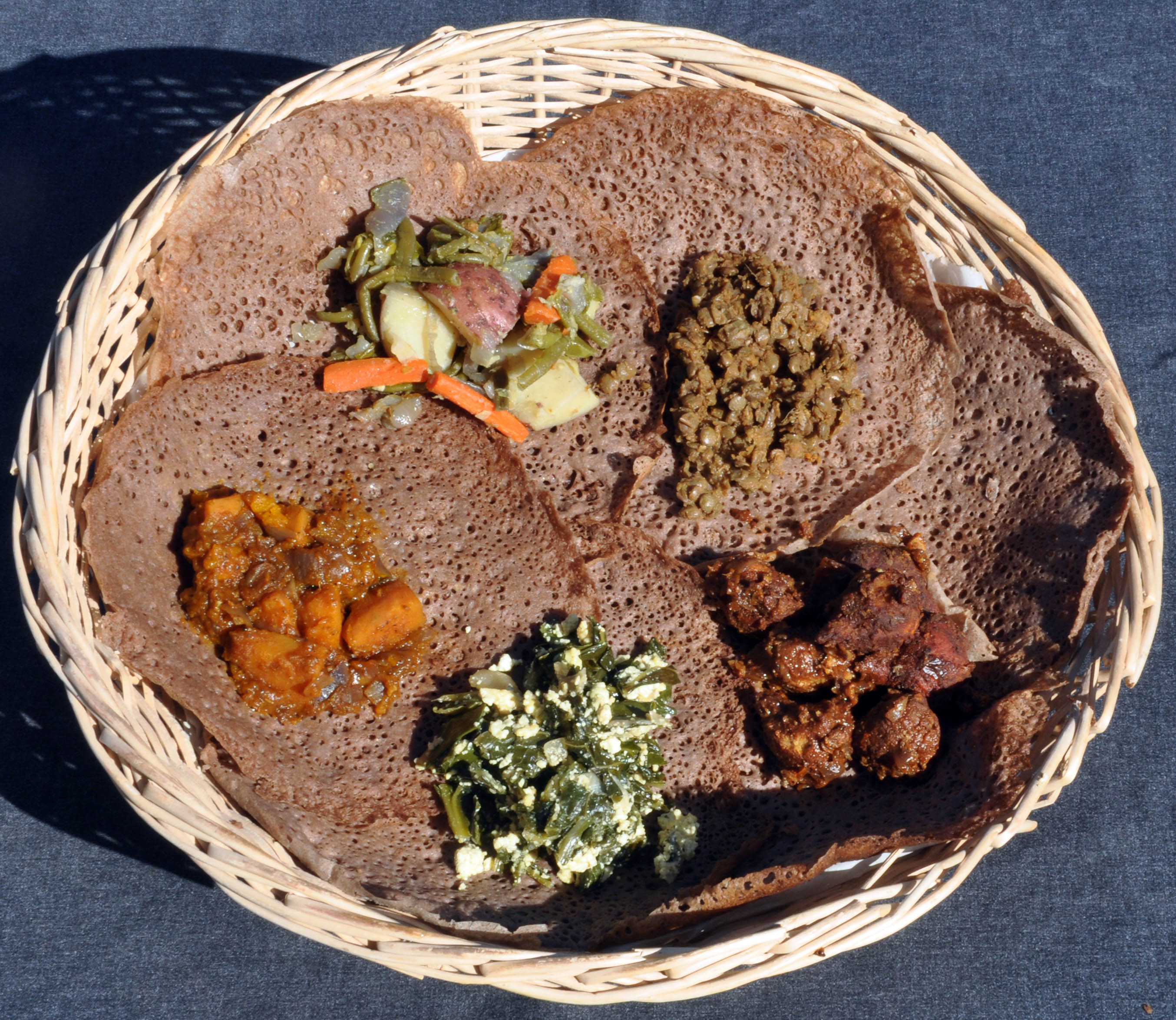
Welcome to Ethiopia, the Cradle of HumanityFor November we’re going to introduce you to one of the most unique vegetarian / vegan cuisines in the world. The Ethiopian culture is centered on the Ethiopian Highlands which lie at the northern end of the Great Rift valley. This region is ecologically unique, representing a high volcanic plateau ranging between 6000 – 9000 feet, with the highest peaks almost reaching to 15,000 feet. The cool temperatures, abundant monsoonal rainfall, and rich volcanic soils have allowed these highlands to exist as an extensive temperate island isolated from similar climates by vast extents of lowland tropical forest, savanna, and the Sahara desert. The oldest hominid fossils (Ardipithicus ramidus – dated at 4.2 million years old) as well as the 3.2 million year old ‘Lucy’ (Australopithecus afarensis) were both found in the Awash Valley of Ethiopia's Afar region. The oldest bones displaying butchering marks – at 3.4 million years of age – also come from the Awash Valley, while the earliest known human tools – at 2.5 million years of age – were found near Gona. The earliest anatomically modern human fossils – at 200,000 years of age – were found by Richard Leakey near the Omo River at Kibbish. 5000 years ago traders from the Old Kingdom of Ancient Egypt returned from the Land of Punt bearing myrrh, gold, ivory, ebony and other goods. Although there is controversy regarding exactly where Punt lay, recent genetic analysis of an Old Kingdom baboon mummy strongly suggests that it was centered on the Ethiopian Highlands. By 3000 years ago, the Greek Herodotus used Αἰθιοπία – ‘Ethiopia’ in Latin script – to refer to the lands south of Egypt. This name appears twice in Homer’s Iliad and three times in the Odyssey. Ethiopia has close historical ties with all three of the world's major Abrahamic religions. From 2000-2500 years ago, Jews displaced by political turmoil and warfare in the Levant traveled down the Red Sea and ultimately west into the Ethiopian Highlands. There they established their own unique form of Judaism. A thousand years later, the Kingdom of Aksum was one of the first nations to officially accept Christianity, when St. Frumentius of Tyre converted Emperor Ezana during the 4th century. Christianity likely had even earlier roots in the area as Acts 8:26–39 states that an Ethiopian royal official was baptized by Saint Philip. Like Judaism, through cultural isolation the Christianity that took root in the Ethiopian Highlands developed a unique flavor, although remaining closest to other Orthodox branches. Islam came 300 years later, when the Prophet Muhammad encouraged followers to escape persecution in Mecca. These disciples subsequently migrated to Ethiopia via modern-day Eritrea. Bilal ibn Ribah, the first Muezzin and one of the foremost companions of Muhammad, was from also from Ethiopia. By 8000 years ago a diverse suite of agricultural crops had been domesticated in the cool, rainy Highlands. Because of their isolation, many of these – such as the grain Teff, the root crop Ethiopian Banana, and the oilseed Niger – never expanded far outside of the region. Coffee, which also originated in the Ethiopian Highlands, is a much more recent crop, perhaps being domesticated no more than 1000 years ago. When encountered at that time by Islamic merchants it rapidly spread throughout the Arabic world. Trading between the Ethiopian people and Egyptians, Greeks, Romans and Arabs greatly enriched the available food plants, with a number of additional grains (especially barley, wheat, and millet), pulses (chickpeas, lentils, favas), and vegetables (collards, cabbage, carrots, onions, garlic, okra) being introduced and grown in the Highlands. Following contact with the New World, more crops were rapidly adopted, including chili peppers, potatoes, and pumpkin. A number of spices used extensively in Ethiopian food, like bishops weed (ajowan), sacred basil, nigelia, nutmeg, black and long pepper, turmeric, ginger, cinnamon, and cardamom are also common to Pakistani and northwestern Indian cuisines, and it seems likely that these flavorings were brought to the region by Islamic merchants over 1000 years ago. Ethiopia is the only African country to have defeated European colonists and remained independent throughout the 19th and 20th centuries. Combined with its physical and cultural isolation, this has allowed the Ethiopian cuisine to be uniquely different from all others, in particular by the by the use of numerous ‘sweet’ spices in savory dishes. Richly flavored stews (termed wat) represent one of the most common foods. In these some focal ingredient is cooked with seasoned oil, berbere paste – made from chilies and a large number of spices – and an abundance of onion. Mild stews (alich’a) are similar, but usually forgo the berbere paste. For a meal these dishes are served on a communal plate or shallow basket which has been layered first with sourdough crepes (injera). Diners then tear their own injera into pieces which they use to pick up the food with their fingers. Jeff has always felt that the best part of an Ethiopian meal happens when the bottom layer of injera, which has absorbed all the various stew sauces, is eaten at the end of the meal.
In the Ethiopian Church fasting occurs 208 days of the year, including Wednesdays, Fridays, and all of Lent. As a vegan diet is required during these times, the Ethiopian cuisine has become one of the world’s great reservoirs for vegetarian and vegan recipes. Yet in spite of this it remains comparatively unknown in the west. This month we’re going to introduce you to this glorious cuisine and show you how to make a vegetarian Ethiopian meal. Because we’re using some dairy products, it would not be appropriate for a fast day; but it can be easily adapted to vegan rules, and we’ll tell you how. It is not easy to find Ethiopian recipes; we know of no Ethiopian cookbook published by any of the major publishing houses. As a result, we’ve pieced the following meal together using recipes from three sources: a chapter in The Frugal Gourmet on our Immigrant Ancestors by Jeff Smith (1990), the African Cooking volume of the Time-Life Foods of the World (1970), and the self-published Exotic Ethiopian Cooking by Daniel Mesfin (1990; ISBN 0961634529). Archive |



